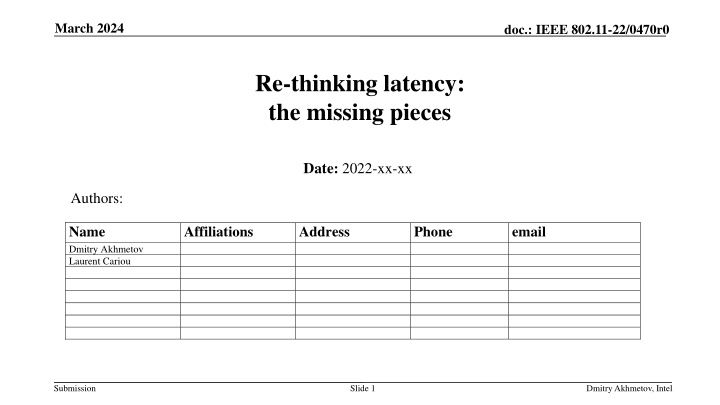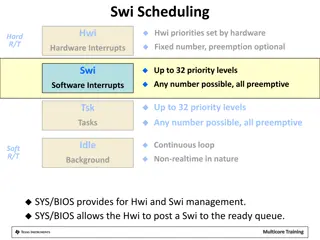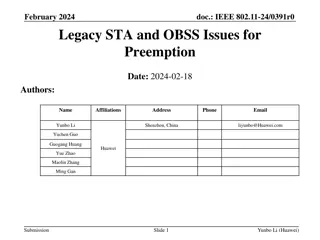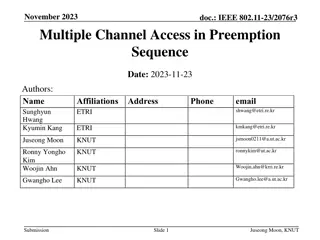Re-thinking Latency Improvement in WLAN Connectivity
This document delves into the latency issues in WLAN transmission, focusing on channel occupancy and access problems that contribute to delays. It discusses the objectives of the UHR Study Group in enhancing WLAN reliability, reducing latencies, managing throughput, and minimizing power consumption. Key solutions proposed include utilizing preemption for channel occupancy to address prolonged medium occupancy problems.
Download Presentation

Please find below an Image/Link to download the presentation.
The content on the website is provided AS IS for your information and personal use only. It may not be sold, licensed, or shared on other websites without obtaining consent from the author.If you encounter any issues during the download, it is possible that the publisher has removed the file from their server.
You are allowed to download the files provided on this website for personal or commercial use, subject to the condition that they are used lawfully. All files are the property of their respective owners.
The content on the website is provided AS IS for your information and personal use only. It may not be sold, licensed, or shared on other websites without obtaining consent from the author.
E N D
Presentation Transcript
March 2024 doc.: IEEE 802.11-22/0470r0 Re-thinking latency: the missing pieces Date: 2022-xx-xx Authors: Name Dmitry Akhmetov Laurent Cariou Affiliations Address Phone email Submission Slide 1 Dmitry Akhmetov, Intel
March 2024 doc.: IEEE 802.11-22/0470r0 Problem space for UHR The UHR SG objectives is : The Study Group will investigate technology which may improve reliability of WLAN connectivity, reduce latencies, increase manageability, increase throughput including at different SNR levels and reduce device level power consumption. There are at least two aspects of transmission over wireless medium that directly contribute to the latency KPI 1. Channel occupancy An ongoing transmission (long PPDU) or series of frame exchanges (within TXOP) prevent a STA from even attempting to access the medium The longer the medium occupancy period, the larger the delay is 2. Channel access To transmit, a STA or an AP shall obtain a TXOP through contention with other WiFi devices A failed contention (in a combination with TXOP duration), especially multiple consecutive failures, lead to latency increase A combination of the two lead to large delay values even for traffic streams with AC_VO priority Submission Slide 2 Dmitry Akhmetov, Intel
March 2024 doc.: IEEE 802.11-22/0470r0 Latency problem EDCA channel access In general OK for LL traffic as it provide traffic prioritization Cover the need for most LL apps that can tolerate waiting for completion of an ongoing TXOP or even few TXOPs Generally, work for all scenarios and traffics: UL, DL , in presence of OBSS, etc. In general cover latency needs for as low as 10th of milliseconds (10-20-30ms or so) Bottleneck : EDCA does not guarantee a transmit opportunity. It is by the nature a source of latency spikes / long tail latency Even higher priority AC may have difficulties obtaining a medium at a right time Harder to achieve sub 10th ms latency For latency needs of 10th of milliseconds, just need to cut the tail Prolonged medium usage. Is a barrier for latency in the order of single digit milliseconds, i.e. latency needs may not tolerate waiting for completion of ongoing TXOP or previously missed TX opportunity Legacy solution for that is to limit TXOP to a small value including for both BSS and OBSS But in any case, that force to fallback to wining the medium through EDCA Limiting TXOP lead to inefficient use of airtime and TXOP level preemption help to reduce the impact on throughput STAs may not be able to flush TX buffers quickly, so they should be active for a longer time and contribute to increased collision rate We can utilize already discussed TXOP level preemption for that, but With OBSS, if we want TXOP level preemption to be used in a way to allow longer TXOP while allowing quicker access to the medium for LL streams, the only way for that to work is to allow preemption of every DL and UL TXOP by everySTAincludingOBSS. Submission Slide 3 Dmitry Akhmetov, Intel
March 2024 doc.: IEEE 802.11-22/0470r0 TXOP Preemption for channel occupancy Preemption* seems to be a perfect solution for the prolonged medium occupancy problem We already converg(ed)ing on many aspects of it: Use origin of a latency sensitive traffic or LL-stream and TXOP ownership for classification TXOP fragmentation into a sequence of short xIFS separated frame exchanges Indication of preemption enablement, i.e. this can be preempted Indication of preemption indication, i.e. I need preemption Seems to be a good alternative vs. setting aggressive TXOP limits Let to keep overall system throughput degradation at acceptable 5-15% level Provide sufficient level of control over TXOP for TXOP owner Sounds good, but.. what about aspects other than long PPDU ? What about OBSS or P2P? Should we be able to preempt those and how? What if there is no long PPDU or TXOP?No prolonged medium occupancy no preemption What if TXOP or PPDU are not preemption enabled? i.e. legacy TXOP? What if only DL TXOP can be preempted or if UL TXOP cannot be preempted by other STA? What else is missing? *without losing generality we can say that preemption is a mechanism to access the medium by interrupting a rightful transmission sequence by an EDCAF that did not obtain the TXOP Submission Slide 4 Dmitry Akhmetov, Intel
March 2024 doc.: IEEE 802.11-22/0470r0 EDCA preemption - before the opportunity is offered to others Too short TXOP or too short TX sequence or non-preemptable TXOP or OBSS TXOP or TX sequence require a LL stream owner to obtain medium using EDCA mechanism Which does not provide sufficient traffic separation and does not guarantee acquisition of TXOP even for high access categories May be hard to achieve 1ms-like latencies without substantial system performance degradation We should consider a mechanism(s) that address the channel access of the latency KPI as well. A TXOP preemption provide to the LL-stream originator almost guaranteed opportunity for transmission as it have a chance to transmit when access to the medium is already obtained by someone When LL stream owner is required to compete for the medium it should have guaranteed opportunity to win the medium during first available contention window Slide 5 Submission Dmitry Akhmetov, Intel
March 2024 doc.: IEEE 802.11-22/0470r0 Another missing link low latency stream What is exactly meant under to reduce latency ? Below some target X ms (i.e. <10ms? <5ms? <1ms? ); Should 10ms stream use preemption? Decrease number of latency spikes? (i.e. improve 95-99%) Reduce latency for certain traffic? For low latency applications ? A generic latencies ? Who need low latency and what is low latency or ultra-low latency ? any traffic in AC_VO ? or may be some with newUP/TID/AC? i.e. static LL stream definition buffered frames of a stream for which certain delivery delay timer is expiring? i.e. dynamic LL definition this potentially may let any packet to qualify as latency sensitive is it a predictable stream (i.e. CBR-like) or unpredictable (event-based or CBR with large frame arrival jitter)? Essentially the question is - WHAT IS LL STREAM. The IEEE 802.11 has no such definition. We operate with AC and TID/UP What are the target applications? Voice: goes into AC_VO. Latency bounds 30ms. Is it so critical ? Video: goes into AC_VI. Latency bounds 200ms. Some packets more important that others? Can it be critical? XR: Latency (and jitter) numbers directly impact user experience. Defined by user input and video stream (FPS). Various reports say <2-5- 8<10<16<20<40ms. A TCP/ AC_BE traffic: a mouse click on a web link / web page load time. It is best effort, so nothing to expect , BUT! my internet is slow I just clicked and nothing happened, WiFi is bad user experience define importance of the traffic We need to be specific on who is going to use preemption and what is the scale of the solution? Submission Slide 6 Dmitry Akhmetov, Intel
March 2024 doc.: IEEE 802.11-22/0470r0 Conclusion TXOP level preemption is a necessary step towards achieving latencies below 10 ms A possibility to enter someone's TXOP is one of the missing features in WiFi. Must be enabled for all/almost all TXOPs to work properly Contention preemption / enhancements to EDCA for LL traffic is needed in UHR EDCA mechanism is one of the main reasons of latency spikes for all traffic types as it does not guarantee channel access. A LL stream with stringent requirements would benefit from prioritized, guaranteed channel access opportunity even before regular EDCA start Enhancements to EDCA would satisfy latency bounds in the 10th of ms A definition/description of LL stream would be necessary to Help to narrow down the scope of Preemption operations Develop set of rules to limit possible abuse and to keep fairness to other streams Submission Slide 7 Dmitry Akhmetov, Intel
March 2024 doc.: IEEE 802.11-22/0470r0 Backup Submission Slide 8 Dmitry Akhmetov, Intel
Definitions from Oxford Languages Learn more March 2024 doc.: IEEE 802.11-22/0470r0 Preemption: definition from Oxford Languages Dictionary 1. the purchase of goods or shares by one person or party before the opportunity is offered to others. 2. US: the interruption or replacement of a scheduled radio or television program. Submission Slide 9 Dmitry Akhmetov, Intel























